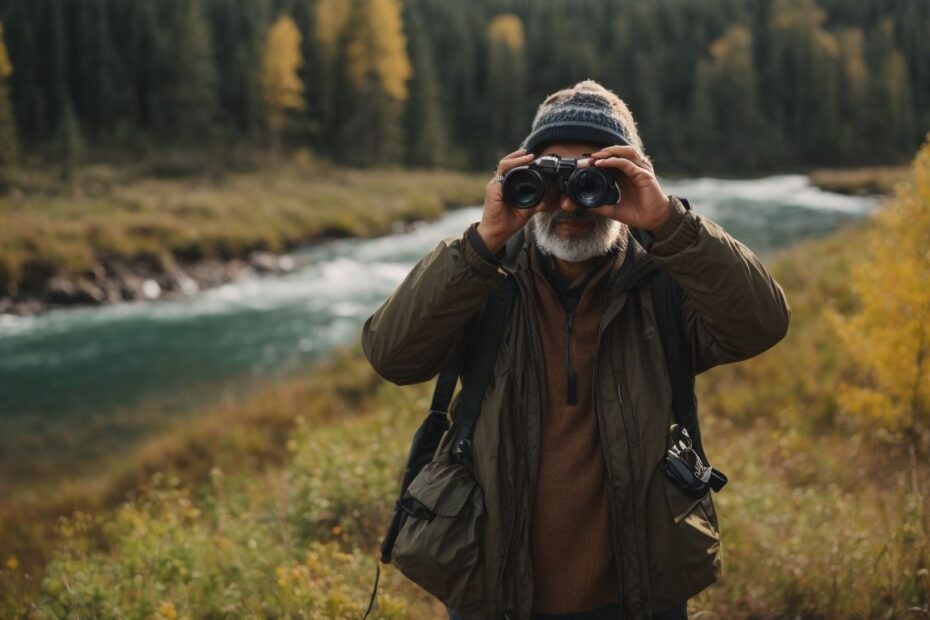The Importance of Using Binoculars Correctly
Using binoculars correctly is crucial in order to fully enjoy the benefits and capabilities of these devices. It is important to understand the importance of using binoculars correctly. Here are some important steps to consider when using binoculars:
- Adjusting the interpupillary distance to match your eyes is of utmost importance for a clear and comfortable view.
- Ensuring that you familiarize yourself with the focusing mechanism and making necessary adjustments will help you achieve a sharp image.
- Using the diopter adjustment is vital to compensate for any difference in vision between your eyes.
- To improve stability and minimize shaking, holding the binoculars steadily against your face is essential.
- Avoiding prolonged staring at a fixed target is recommended in order to prevent eye strain and fatigue.
- Positioning your eyes at the correct distance from the eyepieces will ensure proper eye relief.
- Considering the appropriate magnification power for the activity or observation is key.
- For prolonged or high-magnification use, it is advisable to use a tripod or stabilizing equipment.
- It is important to protect your binoculars from extreme weather conditions and handle them with care.
- Maintaining the optimal performance of your binoculars can be achieved by regularly cleaning the lenses and storing them safely.
By following these steps, you can ensure that you are using binoculars correctly, allowing you to fully appreciate their importance and make the most out of your viewing experience.
Common Mistakes When Using Binoculars
Using binoculars can greatly enhance our outdoor experiences, but only if we know how to use them correctly. In this section, we will uncover the most common mistakes when using binoculars and provide tips on how to avoid them. From holding binoculars incorrectly to neglecting proper lens cleaning, each sub-section will address a specific mistake that many users make. So, whether you’re a seasoned birder or a casual observer, read on to ensure that you make the most out of your binocular adventures!
Mistake 1: Holding Binoculars Incorrectly
Holding binoculars incorrectly is a common mistake that can negatively impact your viewing experience. To avoid this, follow these steps for proper binocular handling:
- First, if you wear glasses, extend the eyecups fully. If not, fold them down.
- Next, place your index fingers on the backside of the binoculars, allowing your thumbs to rest on the front.
- Use your remaining three fingers to secure a firm grip on the binoculars from below.
- Position the binoculars against your eye sockets, aligning them with your field of vision.
- Lastly, keep your elbows close to your body to minimize hand movements and enhance stability.
Now, let me share a real incident that emphasizes the importance of holding binoculars correctly. During a birdwatching trip, a rare species was spotted by a birdwatcher. However, due to improper hand positioning, the binoculars slipped from their grasp and suffered significant damage upon hitting the ground. If the binoculars were held correctly, this mishap could have been avoided, allowing an uninterrupted view of the magnificent bird.
Mistake 2: Not Adjusting the Focus Correctly
When using binoculars, it’s crucial to adjust the focus correctly to ensure clear and sharp images. Here are the steps to avoid the mistake of not adjusting the focus correctly:
- Hold the binoculars steady with both hands.
- Close your right eye and focus on an object using the center focus wheel with your left eye.
- Now, close your left eye and adjust the diopter ring near the right eyepiece until the object becomes clear.
- Open both eyes to check if the focus is correct. If not, repeat the process.
- Remember to adjust the focus for each eye individually if you have different vision in each eye.
Fact: Properly adjusting the focus of binoculars enhances the viewing experience and allows you to see details with precision.
Mistake 3: Using High Magnification Unnecessarily
Using high magnification unnecessarily is a common mistake when using binoculars. Many people assume that higher magnification means better image quality, but it can actually have the opposite effect. Higher magnification makes it harder to keep the image steady and can result in a shaky view. It also narrows the field of view, making it more difficult to locate and track objects. Unless you have a specific need for high magnification, it is best to stick to a lower magnification level for a more enjoyable and stable viewing experience. Mistake 3: Using High Magnification Unnecessarily
Mistake 4: Not Considering Eye Relief
Not considering eye relief while using binoculars is a common mistake that can lead to discomfort and eye strain. Here are some important considerations for proper eye relief:
- Adjust the eyecups: Extend or retract the eyecups to ensure a comfortable distance between your eyes and the lenses.
- Find the correct eye position: Position your eyes so that the entire field of view is visible without any dark edges.
- Check the eye relief measurement: Look for binoculars with a sufficient eye relief measurement, especially if you wear glasses.
Taking these factors into account will ensure a comfortable and enjoyable viewing experience while using binoculars.
Mistake 5: Not Using a Tripod When Needed
When using binoculars, it is important to know when and how to use a tripod to enhance your viewing experience. Here are some steps to follow:
- Assess stability: Determine if the magnification of your binoculars requires additional stabilization.
- Select a tripod: Choose a tripod that is compatible with your binoculars and has a sturdy design.
- Attach the binoculars: Use a tripod adapter to securely attach your binoculars to the tripod.
- Adjust the height: Adjust the tripod legs to a comfortable height for viewing.
- Test stability: Ensure that the binoculars are stable on the tripod by gently moving them.
- Use a remote shutter release: To avoid any movement caused by pressing the shutter button, use a remote release or a self-timer.
- Optimize the setup: Fine-tune the tripod position and adjust the viewing angle for optimal comfort and clarity.
Fact: Using a tripod not only helps reduce hand shake but also allows for extended periods of steady viewing, making it ideal for birdwatching and stargazing.
Mistake 5: Not Using a Tripod When Needed
Mistake 6: Ignoring Diopter Adjustment
- Ignoring the diopter adjustment on your binoculars, which is Mistake 6, can result in blurry images and eye strain.
- To avoid this mistake, follow these steps:
- Start by adjusting the focus on your binoculars to ensure a clear image.
- Locate the diopter adjustment, usually found near the eyepiece or focus wheel.
- With both eyes open, look at a distant object through the binoculars.
- Cover the objective lens of one side and adjust the focus wheel for the uncovered eye until the image is sharp.
- Switch eyes and repeat the process for the other side.
- Once both sides are properly focused, use the diopter adjustment to fine-tune the focus for your individual eyesight.
- Rotate the diopter adjustment until the image appears crisp and clear.
- Remember to reset the diopter adjustment if someone else will be using the binoculars.
- Regularly check and adjust the diopter setting as needed for changes in your eyesight.
- By properly utilizing the diopter adjustment, you can optimize the viewing experience with your binoculars.
Mistake 7: Inadequate Cleaning and Maintenance
Insufficient cleaning and maintenance of binoculars can result in reduced performance and a shorter lifespan. To prevent this error, here are some vital tips for cleaning and maintaining your binoculars:
- Regular cleaning: Make use of a soft brush or microfiber cloth to remove dust and debris from the lenses and body of the binoculars.
- Proper storage: When not in use, store your binoculars in a protective case to shield them from dust, moisture, and potential damage from impacts.
- Avoid harsh chemicals: Use a lens cleaner specifically formulated for optics and avoid the use of strong chemicals or solvents that could harm the lens coatings.
- Check for loose parts: Regularly inspect the binoculars for any loosened screws or other components and tighten or repair them as needed.
- Keep away from moisture: Prevent exposing your binoculars to excessive moisture or rain, and if they do become wet, ensure thorough drying before storing them.
- Professional servicing: Consider periodic professional servicing and cleaning of your binoculars to maintain optimal performance.
Mistake 8: Using Binoculars in Poor Lighting Conditions
Using binoculars in poor lighting conditions is a Mistake 8 that can greatly impact your viewing experience. To avoid this mistake, follow these tips:
- Choose binoculars with larger objective lenses which allow more light to enter, improving visibility in low light conditions.
- Adjust the focus correctly to ensure clear images.
- Use binoculars with a higher magnification only when necessary, as it can reduce the amount of light reaching your eyes.
- Consider using a tripod to stabilize the binoculars and enhance image clarity.
- Clean and maintain your binoculars regularly to ensure optimal performance.
By avoiding the Mistake 8 of using binoculars in poor lighting conditions, you can enhance your viewing experience and make the most out of your binoculars.
Mistake 9: Overlooking the Importance of Objective Lens Size
- When using binoculars, one common mistake to avoid is overlooking the importance of objective lens size. Here are some tips to help you understand why it matters:
- Light gathering: A larger objective lens allows more light to enter the binoculars, resulting in brighter and clearer images.
- Low-light performance: A larger objective lens size improves the binoculars’ performance in low-light conditions, making them suitable for activities like stargazing or birdwatching at dusk or dawn.
- Improved clarity: Objective lens size affects the sharpness and resolution of the images you see through the binoculars.
To maximize your binocular experience, consider the objective lens size based on your specific needs and preferences. Keep in mind that larger objective lenses also mean heavier and bulkier binoculars, so strike a balance between portability and optical performance.
Mistake 10: Improperly Storing and Transporting Binoculars
Properly storing and transporting binoculars is crucial to avoid damage and maintain optimal performance. By following these essential practices, you can ensure the longevity and functionality of your binoculars. Take note of the following tips to avoid the mistake of improperly storing and transporting binoculars:
| 1. Store your binoculars in a dry and dust-free environment. |
| 2. Protect your binoculars by keeping them in a dedicated case or bag to prevent scratches and impact damage. |
| 3. Avoid exposing your binoculars to extreme temperatures or direct sunlight. |
| 4. Safeguard the lenses from dust and debris by using lens caps and covers. |
| 5. Ensure the secure fastening of your binoculars while transporting them to prevent any potential falls or damages. |
Pro-tip: To maintain their condition and ensure optimal performance, regularly inspect and clean your binoculars.
Related posts:

From the gentle rustling of leaves to the distant chirping of birds, the outdoors has always been my sanctuary. With an innate love for nature, I find solace in the embrace of the wilderness. Whether hiking up scenic trails or simply taking a stroll in the park, the outside world offers endless wonders to discover.
But of all the outdoor activities, bird watching is special. Armed with a trusty pair of binoculars, I spent countless hours observing the magnificent dance of birds in their natural habitat. The thrill of spotting a rare species or simply appreciating the beauty of common birds in action is an experience that never gets old.
For me, binoculars are more than just an optical tool; they are a gateway to a world often overlooked. Every glance through those lenses is an opportunity to connect, learn, and be mesmerized by the avian wonders of our world.

